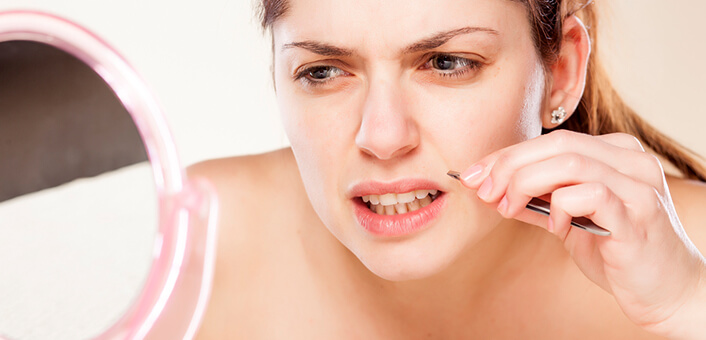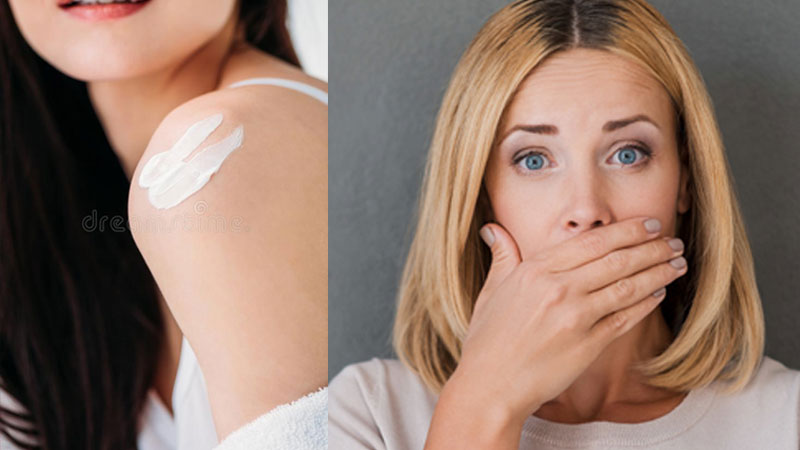
High Testosterone in Women: Causes, Symptoms and Treatments
Testosterone is an important hormone that regulates health, libido, mood and athleticism. But what happens when high testosterone in women occurs? We take a look…
Healthy hormone balance is key to good health.
When your chemical messengers work in synergy you feel happy, positive and full of life. You’re also much more active… and pretty fit too.
But it’s common for women to suffer hormonal imbalance.
In this article we take a detailed look at high testosterone in women, looking at why it might occur and what to do when it does
What is testosterone?
Testosterone is a hormone naturally-produced by your ovaries, adrenal glands and peripheral tissues.
Scientists once thought that testosterone was just a ‘male’ hormone. And that’s kind of true if you take into account they have way more of the hormone compared to us girls.
In men, higher levels of the natural anabolic hormone promote masculinity.
It helps them achieve a more muscular, alpha male frame with chiseled jaws and strong, assertive personalities (take Jason Momoa as an example. Amen to that, girl).
With the evolution of science, we now know that ‘T’ is actually just as important for women
Produced in the ovaries, adrenal glands and peripheral tissues of women, testosterone is classed as a steroid hormone.
Regulated by a part of your brain called the hypothalamus, testosterone production is triggered by the release of another chemical messenger called luteinizing hormone.
Women need it too,
And studies show that low T leads to a number of severe side effects.
Normal testosterone levels in women – more important than you might think

Women need testosterone to ensure optimal health.
And we know you’re thinking it… “hey, won’t testosterone turn me into a man-like hulk of a girl?!”
The short answer is no.
Normal T levels are achieved when your hypothalamus and luteinizing hormones work well together. In women, healthy T levels are around 15 times lower than men.
That’s why us girls get all the benefits with none of the side effects.
Normal levels:
- Men: 300-1,000 ng.dL
- Women: 25-70 ng.dL
Here’s a quick breakdown of normal testosterone benefits:
- It helps to regulate your menstrual cycle, working with estrogen and progesterone to help you maintain a regular cycle.
- Because T levels peak during your most fertile part of the month, scientists believe it’s a key regulator of sex drive.
- Boosts mood and helps reduce day-to-day stress and anxiety.
- Keeps your heart healthy, your bones strong and your blood clean.
- More energy, drive and focus (as well as better sleep!).
- Better stamina, endurance and strength during exercise workouts.
- More toned muscle.
Oh, and the best benefit of all… higher natural testosterone levels are associated with leaner physiques that hold less body fat.
You can check out our article on normal testosterone levels in women here.

Low T is a huge issue for women
Before we start to talk about high T, let’s just cover the point of low testosterone in women. After all, 90% of women over the age of 45 have clinically low androgen levels… with the biggest decline in testosterone production occurring between the ages of 20 and 40.
That’s a frightening statistic!
Low testosterone can cause a number of side effects in women. These include:
- Increased belly fat and muscle loss
- Higher risk of heart disease, diabetes and early death
- Low libido and sex drive (as well as inability to orgasm)
- Higher risk of depression, anxiety and loss of confidence
- Non-existent energy
The causes of low testosterone in women can be varied. Risk factors include taking the oral pill, low circulating progesterone levels and early menopause.
That’s one of the reason SMG use testosterone booster supplements. Not only do they help you maintain hormone levels, they also provide energy, mood and athleticism too… all without side effects!
Find out about our Best Natural Testosterone Boosters in our detailed and comprehensive guide for women.
What are the causes of high testosterone in women?
Causes of high testosterone in women are based on both genetics and lifestyle.
The most common causes include polycystic ovarian syndrome (PCOS), hirsutism and congenital adrenal hyperplasia (CAH).
Steroid use can also lead to sky high testosterone levels and should always be avoided.
#1. Polycystic ovarian syndrome (PCOS)
According to recent statistics, PCOS is a “widespread reproductive disorder that encompasses many associated health conditions and has an impact on various metabolic processes”.
It accounts for as many as 30% of infertility cases in the US, and between 10-20% of women worldwide suffer from the disorder.
In PCOS, testosterone levels are naturally high. Although the exact cause is not known, risk factors include genetic factors, being overweight and having high circulating insulin levels.
PCOS causes the following unwanted side effects:
- Infertility (in some cases)
- Diabetes
- Obesity
- Increased risk of endometriosis
- Facial hair
#2. Hirsutism
This condition is characterized by thick, coarse body and facial hair growth. Common areas affected include the chin, chest and back.
PCOS is a major trigger of hirsutism.
High testosterone can cause hirsutism and hirsutism can cause high T. They have a reciprocal relationship.
It’s thought to be linked to genetics and affects around 10% of women in the west, with slightly more eastern women suffering from the condition.
Symptoms of hirsutism include:
- Male pattern hair growth
- Acne
- Deepening of the voice

#3. Congenital adrenal hyperplasia (CAH)
Your adrenal glands support your ovaries by making testosterone. However, they also make stress hormones such as cortisol (which works against testosterone) and DHEA – a steroid hormone like testosterone.
Those that suffer from CAH struggle to regulate androgen levels. This can lead to a big increase in T and a drop in cortisol.
Symptoms include:
- Acne
- Infertility or irregular menstrual cycles
- Rapid childhood growth but short adult height
- Early appearance of pubic hair
#4. Steroids also cause high testosterone in women
More and more females are hitting the gym to stay fit and look great. Rightly so, girl.
But one worrying issue is that more and more women are succumbing to pressures about how they look and cheating their way to a leaner, athletic physique by taking anabolic-androgenic steroids (AAS).
There’s no denying these drugs boost muscle mass. But steroids are just synthetic testosterone hormones you’re pumping in your body.
Eventually, these ‘supramaximal’ levels of androgen hormones will begin to take their toll. And if you want to see what a typical female steroid user looks like, check out the below image….
It ain’t sexy, girl.

What are the symptoms of high testosterone in women?
While symptoms of high testosterone in women can vary from one person to the next, there are common ones to look out for. These include:
- Acne
- Decreased breast size
- Obesity
- Increased muscle mass
- Deepening of the voice
- Sleep disruption
- Body odor
- Loss of menstruation and infertility
- Enlargement of the clitoris
- Changes in mood – increased assertion, aggression and depression
Diagnosis
If you suspect you have high T levels, you need to visit your doctor for a blood test. This is sent off to a lab where they analyze the amount of androgen hormones in it, as well as a related hormone called SHBG.
If it comes back above the higher end of normal, you’ll be told you have high testosterone.
The test is typically performed in a morning when your natural hormone production peaks.
What are the treatments?
The exact treatment offered to you by your doctor will depend on the root cause.
Common treatments include:
- Oral pill – many contraceptives have a T-suppressing effect and seem reliable in treating side effects such as acne and male pattern baldness.
- Diabetic drugs – medications such as metformin are becoming increasingly used to treat high T and PCOS as they can help with obesity, blood sugar and menstrual cycle irregularities. However, many women experience side effects when using it long-term.
- Lifestyle changes – being active, eating healthily and losing excess body fat is a method often prescribed by health practitioners.
Final Word
Testosterone is a hormone needed by women to regulate menstruation, mood and energy levels. When levels are normal, you feel happier and healthier.
High testosterone in women can lead to several side effects. However, these are all treatable with the right lifestyle and medications.
If you’re concerned about high T speak to your doctor and get a treatment plan to suit your needs.




